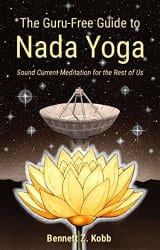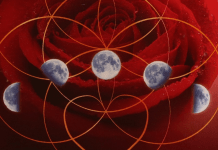
 The Guru-Free Guide to Nada Yoga: Sound Current Meditation for the Rest of Us, by Bennett Z. Kobb
The Guru-Free Guide to Nada Yoga: Sound Current Meditation for the Rest of Us, by Bennett Z. Kobb
Bennett Z. Kobb, B00SSSZ49I, 36 pp., 2015
If you already have an active meditative practice in place and are looking to branch out, The Guru-Free Guide to Nada Yoga: Sound Current Meditation for the Rest of Us is a great resource.
What is nada yoga, or in common language, sound current meditation? Bennett Z. Kobb says, “The Sound Current has been called a signal from the Cosmos, the sound of silence, the Word, and the Audible Life Stream. It certainly seems to come from a distant power source, linked in some mysterious way to the energetic core of being.” In short, nada yoga is the act of learning to listen to those inner sounds. It’s just as simple as it sounds, but it has profound implications.
Nada yoga divides sounds into two categories: ahata, or external music, and anahata, or internal music. Anahata is also the name for the heart chakra, which is said to receive the inner music. The perception of anahata, which is frequently heard as a ringing in the ears, similar to tinnitus, is a common side effect of rising kundalini, or the onset of enlightenment.
I am a complete and utter sonic fanatic, and welcome any opportunity to meditate with sound.1 While I cannot emphasize enough the benefits of a dedicated, regular meditative sitting practice — which I would agree, is probably the most effective tool for fostering mindfulness in your daily life — I also find it to be, at times, escapist, and out of touch with the modern world. Yes, we all love silence, spaciousness and stillness, but how often do you find them in a crowded urban city centre? It would behoove the serious student of the occult to have more tools in their gris-gris pouch, and in my opinion, the more the better.
The Guru-Free Guide to Nada Yoga is a very slim tome, indeed, more of a pamphlet or booklet, and while some readers may wish for a more thorough overview — more back story or personal anecdotes — it makes for a very streamlined guidebook, one that tells you everything you need to know to begin practicing nada yoga.
Kobb recommends sitting in a chair with armrests, with your feet flat on the ground. I have the blessing or curse of being a triple air sign (Aquarius sun, Libra moon, Gemini rising), so I have serious trouble grounding so this posture, alone, is always of great usefulness to me. I also went for my thumb tips in the ears, rather than earplugs, as I didn’t have any at hand.
I did five minutes of closed eye qi gong, to start, to further enhance the grounding and try and settle my mind a bit before beginning. In practice, nada yoga doesn’t feel all that different from normal sitting meditation, although it was a bit strange to be sitting in a chair rather than on my usual zafu, in warrior pose. It was kind of nice — a bit more relaxing and informal than my usual sitting practice. And then I sat, and listened, for 15 minutes, to the sound with no origin, the sound of the cosmos, or of my nervous system buzzing.
Like I said, I am an auditory fiend, so this idea of the sound of chakras singing is nothing new to me (although it doesn’t diminish the revolutionary implications a smidge). Like anyone who’s had some transcendental experiences, and been to way too many metal concerts, noise shows, and raves, my ears are constantly abuzz, and I’ve learned how to tune into — and tune out of — these frequencies. It was interesting to lean into the vibrations, rather than trying to block them out, or be irritated.
I didn’t experience any mind-blowing epiphanies, but I’ve only tried the technique a handful of times. In my experience, any new meditative technique takes about a month of regular implementation for the changes to truly take hold.
I did, however, experience the wakefulness and positivity at the end that Kobb said I would experience, and I believe I felt some of the karmic or energetic cleansing everybody mentions. I have been feeling more peaceful, more patient, and more empathetic since I began experimenting with these techniques. I also feel lighter, airier, more imaginative, and less restrained.
While I may not have stared into JHVH’s corneas this time, I have had experiences in the past, comparable to what Kobb calls “colossal orchestras, always shifting, never repeating,” and it is a staggering, awe-inducing sensation to be sure.
The advantage of sound current meditation is that it comes from within, not some external source, which emphasizes reliance upon your own authority, your inner divinity, rather than relying on some gadget or guru. Nada yoga — in particularly the anahata — teaches you to listen inward, succumbing to your own authority, rather than the domineering voices of politicians and priests.
Bennett Z. Kobb’s The Guru-Free Guide To Nada Yoga is a no-frills guidebook that tells you everything you need to know to find the sound within the sound, within yourself. Kobb’s cool, clear, concise explanations can’t be easily found elsewhere, and it’s nice to have all the information and techniques in one attractive package that is easy to reference and check back with often.
Image credit: Michael Josh Villanueva
- See also J Simpson’s article, “Binaural beats meditation.” [↩]








